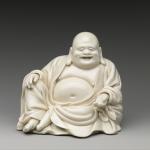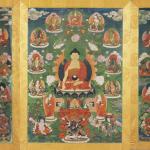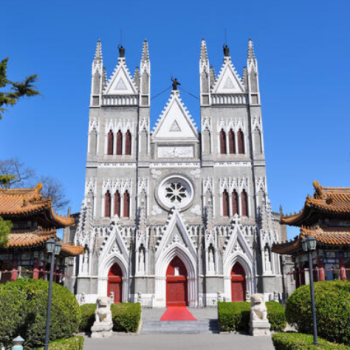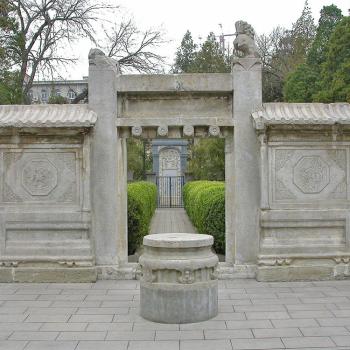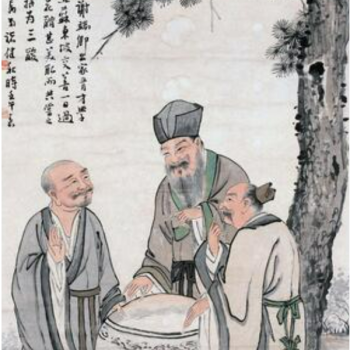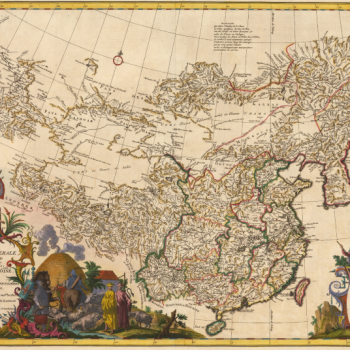We have discussed in detail how much of Buddhist eschatology in China was simply a gloss on indigenous themes and ideas. With all that being said, however, the Buddhist arrival in China did introduce something new into the indigenous apocalyptic scheme. This was a concept of three ages. It was not, however, anything like Joachim’s Three Ages and bore no resemblance to the Three Ages system that would later develop in Chinese eschatology under the Ming. Those systems are both fundamentally optimistic. The orthodox Buddhist system was of a completely different character. It was utterly pessimistic. It also did not cover all of time but only the period related to Buddhism, and especially the Buddhist dispensation initiated by Siddhartha Gautama.
As noted previously, Buddhists had always accepted that eventually the faith’s teachings would disappear and would need to be restored in the distant future. According to Hubert Seiwert, “In China this basic assumption was transformed into the theory of the three stages of the dharma, namely, the True Dharma, the Semblance Dharma, and the Final [Period of the] Dharma” (Seiwert 129). Other scholars offer more prosaic but perhaps more revealing translations of the basic terms, zhengfa, xiangfa, and mofa. For instance, Burton Watson, in his translation of the Diamond Sutra, calls them the “Correct Law,” the “Counterfeit Law,” and the “Latter Day of the Law” (Watson 74) while Zürcher uses “True Doctrine,” “Counterfeit Doctrine,” and “Final Age of the Doctrine” (Zürcher 8). Regardless, all translations convey the same basic idea when it comes to the three ages.
The first period, that of the “True Dharma,” is the time of Siddhartha Gautama’s original teaching and of his immediate disciples’ efforts to codify his words into the doctrines of Buddhism. During this time, the faith is pure and uncorrupted. It is easy to find out what the Buddha’s truly taught and thus follow his precepts. This period may have lasted one-hundred, five-hundred, or a thousand years, but it is generally agreed to be over. The second period, that of the “Semblance Dharma,” is the era most later Buddhists would see themselves as living in. During this time, Buddhism becomes corrupted. Formal religious figures such as monks and nuns live hypocritically, professing a faith they no longer believe in. It thereby becomes difficult to know what the Buddha’s true teachings are with so many false doctrines swirling around. After this comes the period of the Final Dharma, when Buddhism goes completely extinct, the Buddha’s words are entirely forgotten, and enlightenment becomes utterly impossible. At this stage, the faith will be no more.

It should be evident how much this system differs from Joachim’s. Joachim saw the Three Ages as leading progressively to the fuller realization of spiritual truths and the wider availability of salvation. The Buddhists, on the other hand, saw truth and salvation as becoming less available over the course of their three ages. Whereas Joachim was going one way, the followers of Buddhism were going the other. They had more in common with Augustine and his pessimism than with Joachim. What is more, Joachim’s theory of the Three Status incorporated all of time, for his ambition was to lay bare the inner workings of the time itself and explain the whole course of history. The Buddhist three ages, on the other hand, was not a universal theory of history but only addressed the progression of the faith itself. It laid out the life-cycle of Buddhism and did not go say much about history beyond Gautama’s dispensation. It gave a paradigmatic example of how all forms of Buddhism would develop across time but it attempted nothing like Joachim’s effort to explain the processes behind all history. It was, in short, a very different beast from the system that Joachim would propose. The Buddhist three ages theory functions as a useful reminder of the caution I issued previously, namely, that not every division of time into three eras offers a parallel with Joachim’s formulation.
Despite this, it was common for older scholars to simply assert that the later Three Ages system of the Ming era derived from the orthodox Buddhist concept. This simply cannot be. They were, as we shall see, very different in how they conceptualized time and the progress of the faith. The Buddhist three ages did find their way into popular eschatology, where they had their uses. The general conviction that the Final Dharma age drew near was used to bolster claims of Maitreya’s imminent advent. And the condemnation of the Buddhist religious hierarchy inherent in the idea of the Semblance Dharma resonated particularly well with the millennialist movements, which throughout Chinese history drew most of their numbers from the laity and looked with suspicion on those who underwent formal ordination to join the official religious bodies. But the ultimate message of the Buddhist three ages, the overarching pessimism about Buddhism’s survival, was completely lost. It simply could not maintain its full force when inserted into a narrative that promised an imminent transformation of the world for the better, at least as far as the “seed people” were concerned.
Thus, this neutered form of the three ages lived on in apocalyptic thought. But they never became a central and defining aspect of Chinese eschatology in the way the later Three Ages would. What is more, the content of the two systems were completely different. Like Joachim’s own conception, the Three Ages of popular sectarianism offered a universal history of the world and a positive one at that. In this system, just as in Joachim’s own, spiritual knowledge and the reach of salvation would increase over time, reaching their height in the third age. The old tripartite scheme did not disappear when the new one arrived. The old ideas of Semblance and Final Dharma were sometimes used to illustrate the argument that a decline in the quality of the second age would necessitate the kind of renewal offered by the third, itself another analogue to what we saw in Joachim’s own system. But the mere fact that the two systems could be used together demonstrates that Chinese apocalyptic thinkers saw them as separate and distinct. They recognized from the first that the new Three Ages idea had a totally different application than its predecessor, and thus there was no reason for them to draw from the old idea when creating the new one.
That being said, not all scholars of previous generations were quick to latch onto this Buddhist idea as the source of the later sectarian conception of three historical ages. Many of them were quite happy to locate that source instead in Manichaeism, in what we can now see is a common occurrence in the study of more obscure and esoteric religious concepts. Much as scholars have done here in the West, scholars of Chinese religion were once far too impressed by the fact that the Manichaeans believed in three cosmic periods of existence and drew the conclusion that this must be were the later sectarians of the Ming and Qing got the idea. This proposal proved popular, if for no other reason than because it was then a commonplace to attribute all developments in Chinese eschatology to Manichaean influence. There was, for a long time, barely anything in China’s popular narratives of the end-times that was not simply written off as a borrowing from the religion of Mani. This fate befell the beliefs of the late imperial sectarians as it did everything else.
This viewpoint has fallen increasingly out of favor. More recent scholars doubt that Manichaeism had any sort of lasting influence on Chinese apocalypticism. While Manichaeism certainly maintained a foothold in southeastern China for many centuries, its penetration into the cultural and religious mainstream was fairly limited. When Chinese authors talked about it, they tended to mistakenly regard it as a kind of animism, attributed rituals to the faith that it did not practice, and eventually just used it as a catch-all term for any heretical sect. This suggests that general knowledge about what Manichaeism actually taught was low and that the faith itself was never popular or widespread enough to make the kind of impression on Chinese religious and eschatological thought that more successful rivals like Buddhism and Taoism were able to.
As to whether the Manichaeans introduced the specific Three Ages concept that Ming sectarians later popularized, the same criticisms I made regarding their relation to Joachim apply here. The Manichaean scheme did not delineate historical time within the world, as Joachim’s system did and the Ming sectarian one would go on to do, but incorporated the things before and after the existence of the cosmos. The lifespan of the universe was simply the middle stage, and not a particularly good one at that. The followers of Mani did not put forward a notion of historical progress and of greater perfection achieved within time, as these later systems would. Daniel Overmyer offers a succinct but thorough critique of claims of Manichaean influence in Precious Volumes, although it is sadly relegated to an endnote rather than being included in the main body of the text. His comments on the Manichaeans’ and sectarians’ respective three-period systems are worth quoting in full:
The terms for the three time-stages are different and have different meanings. The san-chi of Manichaeism refer to the past, when the principles of light and dark were first distinguished; the present, when there is a struggle between them; and the future, when these two forces are in each person (and when salvation is possible through their separation). This is manifestly not the same as the Buddhist and pao-chuan teaching of different buddhas being in charge of salvation in three successive time periods (san-shih). (Overmyer 384, n. 57)
The distinction which Overmyer makes is the same one that I emphasized in my previous treatment of Manichaeism. The Manichaean story is one of primordial light becoming trapped by darkness in this world and its eventual escape from our world as its formerly pristine nature is restored. As Overymyer states, the first period is the one of original purity, when light and dark were complete separate and light had not yet been corrupted by darkness. This was before the world’s creation; it is the intermixture of light and darkness that creates our cosmos in the second period. The whole life of our world fits in the second period and that era ends with its destruction. The event of the world’s creation is to be regarded as a tragedy because it meant that light ceased to be pure and distinct; this primordial mistake can only be rectified by the escape of light, the end of the cosmos, and the “salvation” which Overmyer attributes to the third period.
This is again, the “fall and redemption” story that we have seen before, which is quite distinct from any notion of three historical ages. Indeed, our whole world and all of historical time represents the period of man’s fall in the world of mixture and matter. Only by the final escape from this fallen world and the universe’s end can true salvation be achieved. Overmyer’s summary of a second age defined by the struggle of light and dark may remind one of Joachim’s designation of the Second Status as one caught “between flesh and spirit” (Lib. Con. 2.1.4), but the similitude is in word choice, not content. The feature so characteristic of Joachim and the Ming sectarians, of each age serving as a moment of increasing salvation from the one before, is completely absent. Joachim had the Three Status assigned to the Father, the Son, and the Holy Spirit, which the work begun by each Person of the Trinity in their respective age being brought to perfection by the other Persons in those that followed. The Ming sectarians assigned their three ages to three successive Buddhas, with each coming along to further the salvific work undertaken by the previous two. Both of these emphasize the sequential nature of the process of salvation and its ever-advancing progress. They are resolutely historical.
Unlike the Manichaean system, those of Joachim and the sectarians take place within the confines of this world, in time rather than eternity. Joachim never made the mistake of extending his system to before the creation or to “the new heavens and new earth.” He never confused the Third Status with the unending aeon of bliss to follow. As for the Ming sectarians, their earliest-known text, the Huangji jieguo baojuan, speaks specifically of “the three buddhas of the time after creation” (qtd. in Seiwert 278), clearly differentiating the lifespan of the world (called houtian) and its three buddha-ruled ages from what came before in the divine sphere (the era of xiantian). While both of these conceptions naturally considered historical time in light of eternity, their three ages were resolutely historical and of this world, not encompassing anything before it or what was destined to come after its own end. In its most fundamental respects, the sectarian system, like Joachim’s, was so unlike anything in Manichaeism that their ideas cannot have been borrowed from nor inspired by the faith of Mani.
With neither of orthodox Buddhism nor Manichaeism panning out as possible sources, scholars have more recently turned to Taoism, which was also had a tradition of temporal speculation. Not to be outdone by their Buddhist opponents, medieval Taoists developed their own system of three ages. Texts such as the Lingbao scriptures began to divide time into periods called yuan or “primes.” This in turn gave rise to the concept of sanyuan, the three primes. The three primes could indicate a number of things but were sometimes interpreted as three unfathomably vast ages which encompassed the whole lifespan of the cosmos. As in Joachim’s system, these three ages would invariably end in the same fashion, brought to an end by identical kinds of cataclysm—though whereas Joachim imagined human Antichrists, the Taoists expected extraordinary natural disasters. The idea of a calamitous end of the age was already well-established in Chinese eschatology but the notion of the three primes gave it more of a set structure. The three primes would later find their way into Ming-era sectarian thought, where the term was occasionally applied to the sectarians’ own Three Ages. Given this, Overmyer and other recent scholars have been quick to accept the Taoist sanyuan, and not the Buddhists’ three periods of the dharma, as the model for the later sectarian Three Ages scheme.
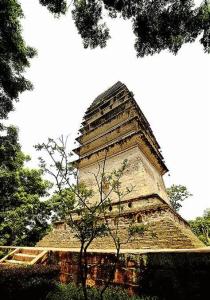
They should not be so hasty. Though the Ming sectarians might have taken some cuts from earlier Taoists, the Three Ages system that they developed was something entirely new. As much as they drew from earlier Taoists, their understanding of time differed from the Taoist sanyuan in several important ways. For one, the Taoist three primes did not always represent the whole history of the world. They could instead be thought of as comprising a shorter time period, such as 180 years, or might not even refer to time at all. The concept as a whole seems to have been quite nebulous and open to interpretation. What is more, the Ming sectarians had a completely different understanding of time and its progress. The Taoists who speculated on the three primes might have hoped for the coming of a messiah and a future era of peace, but their reading of history tended to be as pessimistic and past-focused as that of the more orthodox Buddhists. The golden age had been the best of times and, if the future was to get any better, it was only by returning to that lost excellence—the “fall and redemption” narrative of history that we discussed previously. The three primes themselves did not cast history as a process of positive development and were not a source of future hope. The emphasis was on the inevitable recurrence of calamity and the miseries inevitably waiting at the end of each period. Whereas the sectarians acknowledged that calamities accompanied the ends of the ages, they, like Joachim in the West, tempered this understanding with optimism about the future. As Tak Pui Sze observes in her master’s thesis, “Eschatology in Ming-Qing Sectarian Precious Volumes (Baojuan) and its Daoist Elements,” “Although most sectarian writers divide history into linear stages in their books as Daoist writers do, they do not hold nostalgia for the past like the latter” (Sze 88). The sectarian writers’ hope for the future and their sense that history was moving in an ultimately favorable direction, marked their understanding of the Three Ages as decidedly unlike the Taoists’ view of the three primes.
What is more, as Sze notes, “Although sectarian writers have adopted the Daoist term yuan in their scriptures, they interpret sanyuan in a way different from what we find in Daoism. They seldom equate the three yuan ages with the three ages of the three Buddhas. They also usually show strong fear of the coming of the sixty years of the lower yuan … Hence, the description of sanyuan usually is confusing” (92-93). While some sectarians used the term sanyuan to refer to their own three ages, most did not. The majority recognized a crucial distinction between the two conceptions. As with the Buddhist three ages, they incorporated the Taoist three ages into their scheme but kept them distinct from their own Three Ages of historical development. Like the Buddhist ages, the Taoist ones became a subordinate unit of time with a specific purpose. The sectarians were happy to incorporate the vision of cyclical catastrophe embodied in the three primes. But that was all took. Their vision of cosmic history was ultimately more expansive and comprehensive, going far beyond what the Taoists had imagined. In the aspects that were mostly distinctly their own—the sense of progress and positive movement, of a hopeful future that builds upon all that has come before, and of longstanding processes finally reaching their fulfillment
in a more perfect humanity—the closest parallel is with Joachim, not with anything else on the Chinese scene. Within their own cultural context, the sectarians’ Three Ages idea was a new and unique development, utterly distinct from previous conceptions of time.
Thus, it is clear that, in the heady days and years following the Ming founder’s own successful embrace of end-times prophecy, a wholly new element appeared in Chinese eschatology, the first in a thousand years. What sparked the insight that led to the new Three Ages concept has been lost to time. But once the idea gained currency, it would fundamentally reshape and reorient Chinese apocalyptic thought on a level comparable to how Joachim’s own theory transformed Christian eschatology. What is more, coming two centuries after the Calabrian’s own time and without a viable path of transmission, it somehow managed to reproduce many of the key elements that made his own thought so distinctive. Thus, in Ming-era China we have what, in formulation and influence, is the only truly independent parallel to Joachim’s vision of the Three Status in world history. We shall consider this remarkable occurrence in more depth next time, as we finally turn to the writings of the Ming-era sectarians themselves.
Author’s Note
Keen-eyed viewers will note that the first part of this article originally appeared at the end of our previous entry, “Other Themes in Chinese Eschatology.” I had originally included it there because I thought it served as a fitting conclusion to our discussion of Buddhism’s impact on Chinese apocalyptic thought. However, when I decided that I wanted to do a piece on the proposed origins of the Ming-era Three Ages concept, I realized that it made much more sense to examine the claims for Buddhism, Manichaeanism, and Taoism together rather than separately.
Works Cited
Joachim of Fiore. Liber de Concordia Novi ac Veteris Testamenti, edited by E. Randolph Daniel. Transactions of the American Philosophical Society, vol. 73, no. 8 (1983): pp. 1-455. All translations mine.
Overmyer, Daniel L. Precious Volumes: An Introduction to Chinese Sectarian Scriptures from the Sixteenth and Seventeenth Centuries. Cambridge: Harvard University Press, 1999.
Seiwert, Hubert. Popular Religious Movements and Heterodox Sects in Chinese History. Leiden: Brill, 2003.
Sze, Tak Pui. “Eschatology in Ming-Qing Sectarian Precious Volumes (Baojuan) and its Daoist Elements.” 2003. University of British Columbia, Master’s Thesis.
The Diamond Sutra. Edited and Translated by Burton Watson. The Eastern Buddhist 41.1 (2010): 67-100.
Zürcher, Erik. “‘Prince Moonlight’: Messianism and Eschatology in Early Medieval Chinese Buddhism.” T’oung Pao, vol. 68, no. 1-3 (1982): 1-75.

